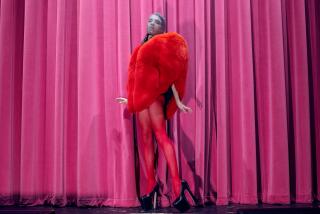Ah, Chance to Buy in Paris Is Too Good to Pass
We went away like proper young women: matched sets of luggage neatly stowed in the plane’s cargo bay, nothing more than trench coats and tote bags over our arms.
We came back 10 days later like ugly Americans: bulging shopping bags in each hand, rolled-up water colors and oil paintings balanced precariously under our arms, and a new leather jacket and our coats, too bulky for the suitcases, stuffed wherever they would fit.
What had happened in between was Paris: the Rue du Faubourg St.-Honore with its Hermes scarfs and Piaget watches, the Left Bank crammed with charming gift shops and fashionable boutiques, the Rue Royale with its crystal, china and silver, and Montmartre with its paintings.
A Trademark Initial
Even in the lobby of the elegant Hotel de Crillon, where we stopped for tea on a Sunday afternoon, we were lured into what the manager billed as Paris’ only hotel boutique with custom-made merchandise, perfect if your initial happens to be C. Everything, from the terry jogging suits and lace-trimmed towels to the crystal Saint Louis decanters, sports the Crillon’s C trademark.
Despite our intentions to visit museums, sip wine on the Champs-Elysees and tour chateaux, we found shopping as irresistible as the Louvre or the Eiffel Tower. In fact, it seems almost impossible not to shop, or at least window-shop, in Paris. The temptations are everywhere.
Our first stop was the department stores on Boulevard Haussmann near the Opera, a good place to get a broad sweep of what Paris has to offer.
Grand Stores
Printemps, at 64 Boulevard Haussmann, turned out to be three separate stores connected by enclosed bridge walkways. In the women’s store, the fourth-floor Rue de la Mode had 26 designer boutiques--everything from Kenzo’s splashy magenta and emerald prints to refined white linen suits and silk blouses by Dior. Yves Saint Laurent, Burberry’s of London, Guy Laroche and Christian Aujard came one right after the other.
It was the same for china and crystal, across the Pont de Cristal walkway into Printemps de la Maison--not just French Baccarat and Limoges but beautiful offerings from all over the world, some very affordable.
Down the street, at Galeries Lafayette, 40 Boulevard Haussmann, the show stopper was the architecture of the store, a soaring stained-glass rotunda with each floor a balcony around an atrium.
We expected to be intimidated and confused by the European sizes and the language; neither of us speaks much French. Instead, we found hostess-interpreters on the main floor in each store, sales help so abundant that it puts Washington-area stores to shame and, in Printemps, a directory in English of everything in the store.
Practically across the street from Galeries Lafayette, American Express at 11 Rue Scribe is a convenient stop to exchange money. Your decision about where you change your money--American Express, a bank, a store or your hotel--may be more important than in the past.
(For those into currency watching, shopping around for rates may be the answer. But you may want to evaluate the impact on your pocketbook versus the value of your leisure time in Paris. We decided to lock in a good exchange rate at home and bought French travelers checks in francs at the National Bank of Washington. That left us more time to spend them in Paris.)
Still on the Right Bank and a short walk from the Opera is the Rue du Faubourg St.-Honore, Paris’ Fifth Avenue. It has all the names, and all with their own boutiques: Saint Laurent, Cardin, Lanvin, Gucci. And, yes, we found bargains, if what you mean by bargains is luxury items that can be had for far less than at home.
The exchange rate worked well for us whether we had an eye on an expensive Baccarat crystal paperweight, which sells for $195 U.S but was 825 francs (about $120 now) in Paris, or a bottle of French perfume that was selling for almost half its American price.
The stores on the Rue du Faubourg St.-Honore were crawling with Americans, including one Chicago woman on a three-hour stopover between planes, who announced in Hermes, “My God, these scarfs are over $100 back home,” and then proceeded to buy what looked like the entire stock for about $65 each.
Exhausted, we took a break for a light lunch topped off by tea and pastries at Angelina’s, at 226 Rue de Rivoli. Another good spot is W. H. Smith’s, 248 Rivoli, an English bookstore with a tearoom.
Just off the Rue de Rivoli is Rue Royale, and within two blocks are stores with silver, china and crystal. Lalique, 11 Rue Royale, looked like a museum of crystal masterpieces, with prices to match (though less than the same items would cost at home).
We liked the wide selection across the street at Delvaux, where one of us ended up buying a small crystal bowl--German, not French--at a great saving. We found it cost about 100 francs to mail the gift home, a modest price that would also have covered a larger, even heavier package, according to the helpful sales clerk.
We didn’t limit ourselves to the better-known shopping areas, but explored some of the neighborhoods that made us feel we were really in Paris. Avenue Victor Hugo, one of the spokes off the Arc de Triomphe, offered major-league shopping like the Rue du Faubourg St.-Honore.
Here, we were told, is where the upper-crust Parisians--who make this neighborhood their home--spend their money. No, some sales clerks could not speak much English, and yes, there was much hand signaling--wider, narrower, taller, shorter--and exchanging of notes on prices. Thank heaven that numbers are the same in French and English.
As we made our way toward the Arc de Triomphe, tucked among the array of clothing boutiques were other enticing stores: Armorial, 26 Avenue Victor Hugo, with embossed leather desk sets and antique crystal ink wells; Un Jardin . . . en Plus, a few doors away, with china, linens and table settings that looked as if they came out of a garden, and Savignac, 11 Avenue Victor Hugo, with beautiful suede and tweed coats for men.
Every block or so there was a bakery to tempt us with a walk-away lunch of ham and cheese on a crispy baguette and tarts of pears, strawberries and apricots, all of which we sampled.
We spent hours, too, poking around on the Left Bank, where the designer boutiques have branches, but where the real finds are the lesser-known shops.
At Maison de la Petite Gaminerie, 32 Rue du Four, owner Leo Bergere had a distinctive selection of infant items such as custom-made cribs, handmade music boxes and unusual baby announcements. He owns two more shops in the block, one for tots and one for the 8- to 12-year-old set.
Nearby, a boutique called Go managed to cram handmade antique lace dresses and blouses, antique picture frames, crystal atomizers and even huge brass headboards into its tiny, cluttered quarters.
At Galerie X, slightly off the beaten path on the Rue des Ecoles near Rue St. Jacques, we bought tiny lamps (about $30 each) with bases made of plump pillows covered in pastel prints with shades to match--compact and lightweight when stuffed into a shopping bag.
At Garreau, 18 Rue de l’Ancienne Comedie, we succumbed to serving trays and place mats painted with pastel landscapes in the style of Monet, pretty enough to make us think of Paris every time we look at them.
Don’t expect the long hours and Sunday openings you’re used to at the malls back home. With few exceptions, this is still a city of small shops. While many Parisian proprietors no longer close for leisurely lunch hours, most close between 5:30 and 7 p.m., and many are closed Mondays.
Our last stops in Paris, in those all-too-brief final hours, were at a bakery for a croissant, an art gallery for a glimpse of a longed-for painting and at Pont-Neuf for one last look at the Seine. There are some things you just can’t take home in a shopping bag.
More to Read
Sign up for The Wild
We’ll help you find the best places to hike, bike and run, as well as the perfect silent spots for meditation and yoga.
You may occasionally receive promotional content from the Los Angeles Times.






